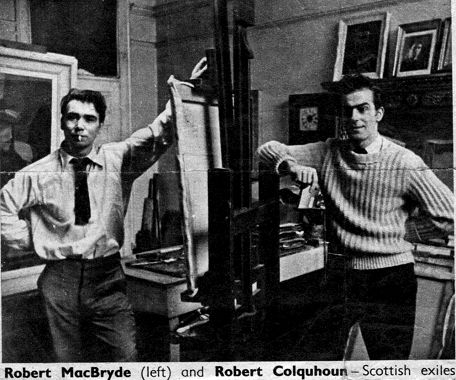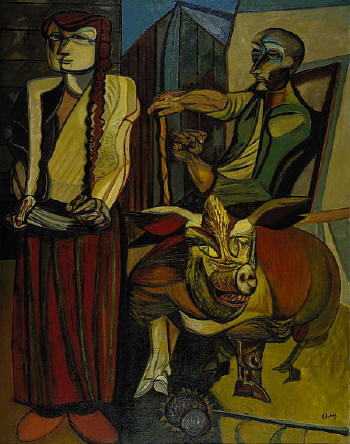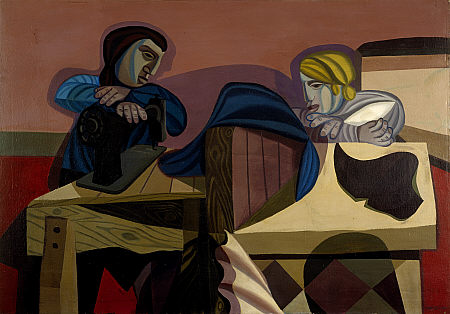|
The Last Bohemians:
Robert Macbryde and Robert Colquhoun
An excerpt from biography of the
neo-Romantic artists, Robert Macbryde and Robert Colquhoun by Roger
Bristow.
In April 1971, a huge mural suddenly and
mysteriously appeared on the face of a stone quarry in the upper slopes
of Craigie Hill, a well-known beauty spot several miles outside
Kilmarnock, a large semi-industrial town in southwest Scotland. The
artist or possibly artists, for the mural was over 55 metres (60
yards) long was unknown. It was a vigorous abstract work executed in
household oil paints. What was especially intriguing about this enormous
painting, however, were the words daubed on a nearby boulder proudly
dedicating the work 'TO THE GREAT COLQUHOUN OUR GREATEST LOSS'.
 The
words referred to the artist, Robert Colquhoun, who had been born and
raised in a working-class family living in Kilmarnock prior to the
Second World War. With his close companion, Robert MacBryde, with whom
he was to spend his entire adult life, he had achieved enormous success
and international acclaim as an artist before sinking into obscurity and
eventually dying at the age of forty-seven, nearly nine years before
this astonishing mural appeared. His devoted partner, MacBryde, who had
been brought up in nearby Maybole in even more modest circumstances than
Colquhoun¹s, outlived his friend by a mere four years before his life,
too, was cut tragically short in a street accident in Dublin. The
words referred to the artist, Robert Colquhoun, who had been born and
raised in a working-class family living in Kilmarnock prior to the
Second World War. With his close companion, Robert MacBryde, with whom
he was to spend his entire adult life, he had achieved enormous success
and international acclaim as an artist before sinking into obscurity and
eventually dying at the age of forty-seven, nearly nine years before
this astonishing mural appeared. His devoted partner, MacBryde, who had
been brought up in nearby Maybole in even more modest circumstances than
Colquhoun¹s, outlived his friend by a mere four years before his life,
too, was cut tragically short in a street accident in Dublin.
The unexplained appearance of the mystery mural excited considerable
interest in the local press. The mural and the subsequent article that
it provoked were beneficial publicity for a small but vociferous lobby
of Colquhoun devotees who wished to propose the founding, in Kilmarnock,
of a memorial to their local artist. To this end, they were successful.
The local council was sympathetic and the town¹s large and prestigious
art gallery and museum The Dick Institute offered its support. Even
more fortuitous was the fact that Colquhoun¹s sister, Sheila, his sole
surviving close relative, had recently unearthed a bundle of over three
hundred of her brother¹s early works. (Colquhoun¹s mother had died in
1969, his father in 1970 and his brother, John, in 1971.) These were to
form the basis of the Colquhoun Memorial Gallery when it was decided
that a fitting tribute to the artist¹s memory and reputation would be
the establishment of a permanent site showing these and other of his
works (and a few of MacBryde¹s) that the Institute had purchased.
 Robert
Colquhoun was to receive the recognition in his home town that, in spite
of great success elsewhere, had eluded him in his lifetime and the years
following his early, tragic death. Robert
Colquhoun was to receive the recognition in his home town that, in spite
of great success elsewhere, had eluded him in his lifetime and the years
following his early, tragic death.
Regrettably this posthumous honour was
short-lived. Five years after the inauguration of the Memorial Gallery,
Sheila Colquhoun (now Wilson) withdrew the loan of the collection of
drawings. Even the annual memorial prize, now seen as an unnecessary
extravagance by an increasingly cost-conscious council, was
discontinued. The apparent indifference, once again, to the work
and reputation of Colquhoun was symptomatic of the British art
establishment¹s wider disregard for him and for MacBryde. This, however,
had not always been the situation.
At the height of their success, in London during the mid- to late-1940s,
Colquhoun and MacBryde, or the 'Two Roberts' as they had become widely
known, were quickly acknowledged as two of the most talented of the
younger British painters to emerge during the early, angst-ridden years
of the Second World War. For a few brief years their reputation as 'The
Golden Boys of Bond Street' remained at its zenith. Not only was their
work regularly shown to great critical acclaim at the Lefèvre Gallery in
London one of the most prestigious showcases at that time but their
extraordinary charisma and the strength of their individual characters
gave them a near-mythical status. MacBryde, with his animated features
and beguiling charm and Colquhoun¹s rugged handsomeness and stoic allure
made them extremely appealing. At a time when male homosexuality was not
only illegal but also actively persecuted, they made little attempt to
disguise the fact that to all intents and purposes their relationship
was a marriage. This public display of courage and honesty combined with
their burgeoning reputations and undeniable talents ensured that they
had a constant stream of admirers, both male and female, who regarded it
as a pleasure and privilege to be in the Roberts' company, enjoying the
widely-revered generosity and charm for which the two artists soon
became famous. The large circle of friends that grew around them
included the painters Michael Ayrton, Francis Bacon, Lucian Freud and
John Minton as well as the poets George Barker and Dylan Thomas, all of
whom would attend the regular Saturday and Sunday soirées that the
Roberts held at their fashionable studio in north Kensington. This was
quickly recognised as the meeting place for many of the most exciting
and creative people in London at that time.
 As
early as June 1943, when still in his twenties, Colquhoun was described
by the critic Robert Melville in his review in the weekly magazine The
Listener as 'the most promising young painter England [sic] has produced
for a very long time.' By 1947, the artist Wyndham Lewis, who had
succeeded Melville in his role as art critic for the magazine, wrote in
a review of a mixed exhibition at the Lefèvre Gallery containing
examples of work by both Colquhoun and MacBryde that Colquhoun was
'generally recognised as being one of the best perhaps the best of
the young artists'. He further went on to say 'Perhaps I should have
said Colquhoun and MacBryde for they work together, their work is almost
identical and they can be regarded almost as one artistic organism.' As
early as June 1943, when still in his twenties, Colquhoun was described
by the critic Robert Melville in his review in the weekly magazine The
Listener as 'the most promising young painter England [sic] has produced
for a very long time.' By 1947, the artist Wyndham Lewis, who had
succeeded Melville in his role as art critic for the magazine, wrote in
a review of a mixed exhibition at the Lefèvre Gallery containing
examples of work by both Colquhoun and MacBryde that Colquhoun was
'generally recognised as being one of the best perhaps the best of
the young artists'. He further went on to say 'Perhaps I should have
said Colquhoun and MacBryde for they work together, their work is almost
identical and they can be regarded almost as one artistic organism.'
These were not the words of one man dogmatically swimming against the
tide of current opinion (as Lewis had sometimes been known to do), for
he was only echoing similar opinions stated by other eminent art critics
including Neville Wallis and Eric Newton. In 1948, the Museum of Modern
Art, in New York, wishing to extend its collection of contemporary
British painters, sent Alfred Barr, then Director of Collections, to
London to purchase works from some of the new wave of British artists.
He selected five works by Francis Bacon, Edward Burra, Lucian Freud,
Robert Colquhoun and Robert MacBryde.
Contemporary art enthusiasts in America would have been familiar with
the work of these painters having seen some of the many touring
exhibitions of recent British painting that were organised by the
British Council; works by Colquhoun and MacBryde were regular and
prominent features of these exhibitions.
By this time, works by the Roberts were in the collections of the Arts
Council, the British Council, the Contemporary Art Society and the
Imperial War Museum as well as being represented in the private
collections of some of the major art patrons of the time. Success then
seemed to have come to them speedily, but the road to that period of
public esteem and its material benefits had been at times intensely
hard, deeply stressful and fraught with risk.
Roger Bristow, the author, lives
in West Cornwall. The Last Bohemians is available from amazon.co.uk:
|

 The
words referred to the artist, Robert Colquhoun, who had been born and
raised in a working-class family living in Kilmarnock prior to the
Second World War. With his close companion, Robert MacBryde, with whom
he was to spend his entire adult life, he had achieved enormous success
and international acclaim as an artist before sinking into obscurity and
eventually dying at the age of forty-seven, nearly nine years before
this astonishing mural appeared. His devoted partner, MacBryde, who had
been brought up in nearby Maybole in even more modest circumstances than
Colquhoun¹s, outlived his friend by a mere four years before his life,
too, was cut tragically short in a street accident in Dublin.
The
words referred to the artist, Robert Colquhoun, who had been born and
raised in a working-class family living in Kilmarnock prior to the
Second World War. With his close companion, Robert MacBryde, with whom
he was to spend his entire adult life, he had achieved enormous success
and international acclaim as an artist before sinking into obscurity and
eventually dying at the age of forty-seven, nearly nine years before
this astonishing mural appeared. His devoted partner, MacBryde, who had
been brought up in nearby Maybole in even more modest circumstances than
Colquhoun¹s, outlived his friend by a mere four years before his life,
too, was cut tragically short in a street accident in Dublin.
 As
early as June 1943, when still in his twenties, Colquhoun was described
by the critic Robert Melville in his review in the weekly magazine The
Listener as 'the most promising young painter England [sic] has produced
for a very long time.' By 1947, the artist Wyndham Lewis, who had
succeeded Melville in his role as art critic for the magazine, wrote in
a review of a mixed exhibition at the Lefèvre Gallery containing
examples of work by both Colquhoun and MacBryde that Colquhoun was
'generally recognised as being one of the best perhaps the best of
the young artists'. He further went on to say 'Perhaps I should have
said Colquhoun and MacBryde for they work together, their work is almost
identical and they can be regarded almost as one artistic organism.'
As
early as June 1943, when still in his twenties, Colquhoun was described
by the critic Robert Melville in his review in the weekly magazine The
Listener as 'the most promising young painter England [sic] has produced
for a very long time.' By 1947, the artist Wyndham Lewis, who had
succeeded Melville in his role as art critic for the magazine, wrote in
a review of a mixed exhibition at the Lefèvre Gallery containing
examples of work by both Colquhoun and MacBryde that Colquhoun was
'generally recognised as being one of the best perhaps the best of
the young artists'. He further went on to say 'Perhaps I should have
said Colquhoun and MacBryde for they work together, their work is almost
identical and they can be regarded almost as one artistic organism.'